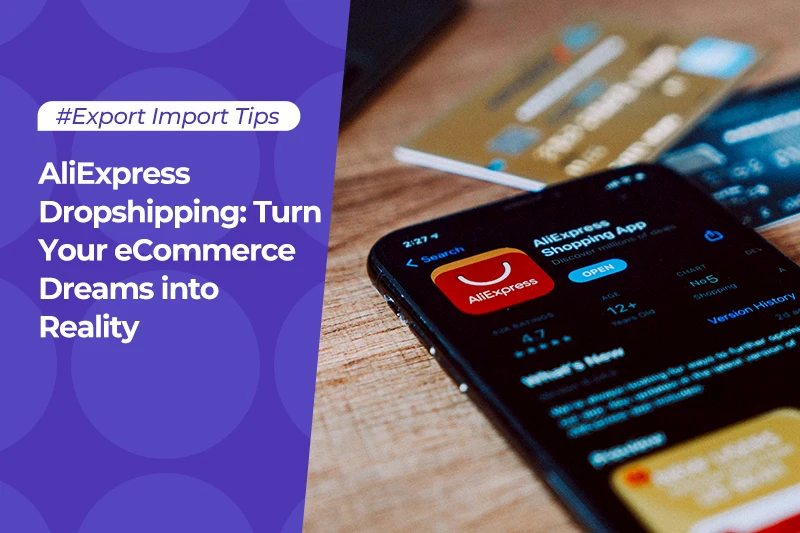How to Export From India for a Profit With Alibaba.com

Expanding and selling your products overseas is a great way to tap into international buyers and increase sales. India offers an attractive business landscape for small and medium-sized enterprises (SMEs) interested in foreign trade. However, breaking into the export sector isn’t always easy.
In this straightforward guide, we’re going to discuss the Indian export market as a whole and weigh the pros and cons of exporting from India. We will also provide key insights into profitable export markets and how e-commerce platforms such as Alibaba.com can help you expand on a global scale.
Table of Contents
Why you should use ecommerce to export your goods
If you’re only selling your goods through traditional local channels, you’re (literally) missing out on a world of sales opportunities.
India is currently experiencing an e-commerce boom due to ongoing urbanization and increased internet accessibility. In the last quarter of 2020, the e-commerce sector registered an astonishing year-over-year growth of 36%.1 By 2023, Statista predicts the country will have over 650 million internet users thanks to India’s direct investment in expanding internet connectivity.2
By selling through online trade platforms like Alibaba.com, you can access a larger pool of potential buyers from around the globe. Going digital also allows you to promote your brand, showcase the benefits of your products, and tailor your offerings to customers based in their own area. These factors and more will enable you to scale your business and improve your bottom line through cross-border trade.
Why you should export products from India
Despite China, the US, Germany, and Japan being the world’s leading exporters of goods, India is rapidly moving up the ranks. India has ranked among the top agricultural exporters in recent years, but more notable is its astounding export growth rate. At 47%, India’s year-on-year growth in merchandise exports from January 2020 to July 2021 topped all G7 nations and is the highest export growth rate that India has ever witnessed.3
So, if you’re a local SME considering exporting goods overseas, then you’re in luck. India’s export sector holds promising market potential for a variety of products and boasts additional advantages, like government-provided incentives, which we’ll discuss later in this post.
What are the top exported goods from India?

Before establishing an export business, make sure there's a market for your product.
Understanding market demand is essential to determining which products you should export. India is known as one of the top markets for exporting precious gems, jewelry, and jewelry accessories, making these goods a popular choice for wholesale sellers. Other major exports include pharmaceutical products to countries like the US and petroleum products to nations like Nepal and Myanmar.4 Agricultural commodities like rice, meat, raw sugar, cotton, and crustaceans are also in high demand.
Here are India’s top 10 export product categories and percentage share of overall exports from 2020-2021:5
- Mineral fuels, including oil (9.2%)
- Gems, precious metals (8.96%)
- Pharmaceuticals (6.64%)
- Mechanical appliances (6.49%)
- Organic chemicals (6.15%)
- Electric machinery (4.87%)
- Vehicles (4.67%)
- Iron and steel (4.15%)
- Cereals (3.46%)
- Plastic, plastic articles (2.35%)
Pros and cons of exporting from India

India’s government aims to achieve a target GDP of US $5 trillion by 2025, and it will probably come close to attaining this goal. However, due to the pandemic, which stalled bilateral trade negotiations and manufacturing processes worldwide, actually hitting this milestone is unlikely.
Even so, the Department of Commerce continues to maintain a positive outlook and remains committed to developing strategies that can triple Indian exports by the same year. Several export schemes are already underway to encourage international trade through financial incentives. That said, there are also some barriers to keep in mind. Let’s examine the pros and cons of exporting from India.
Pros
To support the export sector and encourage foreign exchange, the Indian government is providing a range of financial incentives to local exporters. These incentives not only attract foreign buyers but also help Indian SMEs increase their profit margins. In mitigating costs commonly incurred by exporters, the government can effectively promote cross-border trade and reduce entry barriers for startup businesses.
Examples of export incentives include:
- Duty exemptions, such as duty-free import of inputs required for export production
- Duty remissions, such as rebates of import duties on inputs used for export production
- Low-cost loans
- Subsidies that reduce export prices
Cons
The key challenge for Indian exporters can be summed up in one word: unpredictability.
Infrastructure bottlenecks, shifting policies, and unstable freight costs are concerns all wholesale traders should be aware of in order to minimize risk.
Periodic power outages, insufficiently developed roads, and unstable telecommunication systems can sometimes hinder SME businesses. These infrastructure deficiencies are primarily outside the exporter’s control and can disrupt production and operations. Similarly, trade policies are another factor beyond your control, so keep an eye on updated trade regulations and amendments.
Unpredictable freight costs also pose a significant barrier to local export businesses, especially during a pandemic. Over the previous year, container rates have nearly tripled due to a severe container shortage.6 This unforeseen spike caused the export value of coffee, beef, tobacco, and other products to decline last July.
Fortunately, dealing in international trade doesn’t have to be a risky business. Now that you’re aware of these potential obstacles, you can build an actionable risk management plan to ensure a swift response to unexpected events.
Rules and regulations for exporting overseas

Imports and exports in India are governed by the Foreign Trade Policy (2015-20), which has been extended through to March 31, 2022, in light of the COVID-19 pandemic.7 The Foreign Trade Policy (FTP) is informed by the Foreign Trade (Development and Regulation) Act, 1992.8 This Act enables India’s federal government to make provisions for foreign trade developments and regulations.
Don’t want to find yourself in a sticky situation by failing to observe FTP rules and regulations? We’ve provided a list of some legal requirements you’ll want to follow. (Please keep in mind that specific conditions are subject to change, as mentioned in Pros and Cons.)
Establish a business: Determine whether your company will be a sole proprietary concern, partnership firm, or private limited company. Once you know what type of business entity you want to establish, obtain a corresponding registration form from your regional Ministry of Micro, Small, and Medium Enterprises (MSME).
Open a bank account: Set up an account with a local bank authorized to deal in Foreign Exchange. This will require providing proof of your company’s registration.
Obtain a permanent account number (PAN): After you’ve registered your business and opened a bank account, you can apply for the PAN card from the Income Tax Department.
Acquire a mandatory importer-exporter code (IEC) number: This ten-digit number is required for exporting from India. You can attain this code either by applying directly at the regional office of the Directorate General of Foreign Trade (DGFT) or online.
Attain a registration cum membership certificate (RCMC): To apply for an RCMC certificate, submit an ANF-2C application form to the EPC that pertains to your export product(s). Appendix 2T of the DGFT has a list of EPCs/Commodity Boards/Authorities, their contact information, and products that fall under their jurisdiction.
Select a product: To make sure you’re complying with FTP regulations, once you have selected your product line, check if there are any specific restrictions to be aware of.
Start exporting from India with Alibaba.com
If you want to start an export business, then online trade is a must. Alibaba.com, a well-known global marketplace, has the tools and resources you need to expand into the international market. Our platform offers a host of features and benefits like flexible shipping, trade assurance order protection, and a range of seller services.
Join today and discover just how easy it is to boost your bottom line through digital cross-border trade on Alibaba.com.
References:
1. https://www.newindianexpress.com/business/2021/feb/10/e-commerce-grows-by-36-per-cent-in-last-quarter-in-india-report-2262111.html
2. https://www.statista.com/topics/2157/internet-usage-in-india/
3. https://www.republicworld.com/india-news/economy/india-beats-all-g7-nations-to-record-highest-growth-in-merchandise-exports-in-1-dot-5-years.html
4. https://www.boxnbiz.com/resource/blog-detail/23/top-10-profitable-products-to-export-from-india-to-other-countries
5. https://www.worldstopexports.com/indias-top-10-exports/
6. https://economictimes.indiatimes.com/news/economy/foreign-trade/exporters-boxed-in-by-container-crunch-as-rates-rise-to-7000-10000-in-fortnight/articleshow/85753033.cms
7. https://economictimes.indiatimes.com/news/economy/policy/govt-extends-foreign-trade-policy-till-march-next-year/articleshow/86612950.cms
8. https://www.india-briefing.com/news/import-export-procedures-india-19125.html/
Start your borderless business here
Tell us about your business and stay connected.
Keep up with the latest from Alibaba.com?
Subscribe to us, get free e-commerce tips, inspiration, and resources delivered directly to your inbox.















